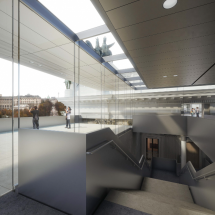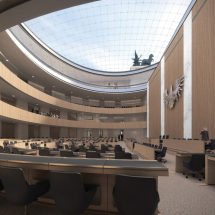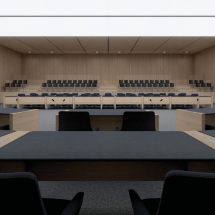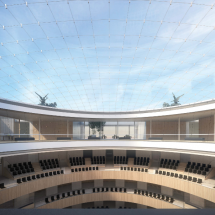Sustainable Renovation of the Austrian Parliament
In January 2014, the crucial decision for the sustainable renovation of the Parliament building was made. The basis for this decision was developed by the project team of the Parliamentary Administration in close collaboration with the project management provided by Vasko+Partner. It included a comparison of all alternative options and a cost breakdown based on an independent review of the cost estimates from the overall concept created in 2011.
In a two-stage, Europe-wide negotiation process, the joint venture of Jabornegg & Pálffy_AXIS was awarded the contract for the general planning services in autumn 2014. Since then, the planning work has been in full swing, with construction set to begin in the summer of 2017.
Vasko+Partner is responsible for project management.
"The task is to preserve the valuable substance of the building while also making it fit for modern parliamentary operations," outlines Alexis Wintoniak, Deputy Director of the Parliament, the planning framework. The former project manager now acts as Managing Director of the Parliament Building Renovation Company (ParlamentsgebäudesanierungsgesmbH), a cooperation between the Parliament and the Federal Real Estate Company (BIG).
Temporary Relocation to the Hofburg V+P is also responsible for the temporary relocation of the Parliament: the National Council and Federal Council will convene in the grand Redoutensaal of the Hofburg. Additionally, three temporary prefabricated pavilions for offices and meeting rooms will be built in the Bibliothekshof of the Hofburg and on the Heldenplatz. The general renovation is expected to be completed by summer 2020. Ongoing assessments of the condition of the Parliament revealed significant deficiencies in terms of fire safety, evacuation options, accessibility, building stability, building technology, glass roofs, roof structure, and the technical lifespan of numerous materials used in the Parliament building.
Accessible and Flexible The adaptation of the Parliament building to future requirements is planned in several steps, oriented by the architectural concept of Theophil Hansen. Historic rooms will be sustainably restored, while their character will be restored through the partial removal of later installations. Additional public spaces will be created on the ground and top floors. In the spirit of further opening up the building, additional opportunities will be provided for visitors to participate in parliamentary life.
All publicly accessible floors will be connected by four new central stairwells, which will not only offer an attractive connection between the different levels but also meet the necessary new dimensions of escape routes.
The design by the general planners Jabornegg & Pálffy_AXIS includes a significantly improved infrastructure for the National Council Chamber. The spatial appearance of the hall will be preserved in its essence with the new architectural modifications. In the ground floor level, the seating ranks of the deputies will be lowered to achieve accessibility. The intermediate ceiling with artificial lighting will be removed, allowing for a view through the new glass roof.
Under the National Council Chamber and the Historischer Sitzungssaal (Historical Session Hall, preserved in its original form), new committee rooms will be added. Unused areas in the top floor will be utilized for offices and meeting rooms. A visitor-accessible restaurant will also be located here. The new additions are arranged in a way that they do not overlay the historic appearance and do not disturb the overall ensemble. The goal is to undertake a substantial restoration of the Parliament, create efficient workspaces, and expand spatial offerings that accommodate the increasing public demand for information and transparency on-site.
The future Parliament building has been awarded the "klimaaktiv GOLD" and "ÖGNB Gold" certificates for the present planning, making it the first building with exceptional historical preservation requirements to receive these honors. Robert Lechner, head of the Austrian Institute for Ecology and chairman of the ÖGNB, stated during the presentation of the planning certificates, "Especially in times like these, the renovation of the Parliament building shows that protected historical buildings can make a significant contribution to climate protection. The Parliament thereby becomes an ambassador for sustainable construction and sends an important signal to those who doubt the Paris Climate Agreement."
| Client | Republik Österreich/Parlament |
| Architecture | Generalplaner Jabornegg & Pálffy_AXIS |
| Full design team | Jabornegg & Pálffy_AXIS |



